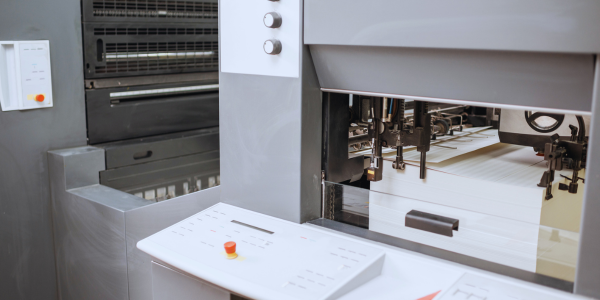-
-
News
-
0 likes
-
1329 views
-
0 comments

Wprowadzenie
Papier offsetowy – Twój niezawodny partner w druku. Zacznijmy od podstaw, czy kiedykolwiek zastanawiałeś się, dlaczego niektóre druki wyglądają tak wyjątkowo, z żywymi kolorami i gładką powierzchnią? Kluczem do tego efektu jest często jeden, pozornie prosty materiał – papier offsetowy. Ten niezwykły wynalazek rewolucjonizował przemysł poligraficzny, oferując doskonałe połączenie jakości, wszechstronności i przystępnej ceny.
Czym jest papier offsetowy i jakie są jego rodzaje?
Zaczęliśmy już od tego, że papier offsetowy to podstawa wielu druków, ale czym tak naprawdę się wyróżnia? Wyobraź sobie gładką, jednolitą powierzchnię, która doskonale przyjmuje tusz i zapewnia żywe kolory. To właśnie charakterystyka papieru offsetowego.
Jednym z najważniejszych czynników różnicujących papiery offsetowe jest rodzaj powłoki. Wyróżniamy:- Papier offsetowy matowy: Idealny do tekstów, gdzie czytelność jest priorytetem. Matowa powierzchnia redukuje odblaski, co zmniejsza zmęczenie oczu podczas czytania długich fragmentów.
- Papier offsetowy błyszczący: Jeśli chcesz, aby Twoje druki błyszczały i przyciągały uwagę, to papier błyszczący jest dla Ciebie. Jego gładka, błyszcząca powierzchnia podkreśla kolory i dodaje elegancji.
- Papier offsetowy kredowany: To połączenie najlepszych cech obu poprzednich rodzajów. Ma gładką powierzchnię, która zapewnia wysoką jakość wydruku, ale jednocześnie jest mniej błyszczący niż papier błyszczący.
Gramatura i formaty
Kolejnym ważnym parametrem jest gramatura papieru, czyli jego masa na metr kwadratowy. Im wyższa gramatura, tym papier jest grubszy i bardziej sztywny. Formaty papieru offsetowego są zróżnicowane i dostosowane do różnych potrzeb, od wizytówek po plakaty.

Zalety papieru offsetowego
Papier offsetowy zdobył ogromną popularność w branży poligraficznej dzięki swoim licznym zaletom:
- Wszechstronność: Nadaje się do druku różnego rodzaju materiałów, od prostych ulotek po złożone publikacje.
- Ekonomiczność: Jest jednym z tańszych rodzajów papieru, co czyni go atrakcyjnym dla dużych nakładów.
- Dobra absorpcja tuszu: Zapewnia wyraźne i trwałe wydruki.
- Możliwość dodatkowej obróbki: Można go łatwo laminować, perforować czy skręcać.
Zastosowanie papieru offsetowego w różnych dziedzinach
- Druk komercyjny: Ulotki, plakaty, katalogi, broszury, czasopisma – to tylko niektóre przykłady materiałów drukowanych na papierze offsetowym.
- Wydawnictwo: Książki, podręczniki, czasopisma naukowe – papier offsetowy jest podstawowym materiałem używanym w produkcji wydawnictw.
- Reklama: Materiały POS, opakowania, gadżety reklamowe – papier offsetowy pozwala na tworzenie efektownych materiałów promocyjnych.
- Opakowania: Pudełka, torebki, etykiety – papier offsetowy jest wykorzystywany do produkcji różnego rodzaju opakowań.
Jak wybrać odpowiedni papier offsetowy do swojego projektu?
Wybór odpowiedniego papieru offsetowego może mieć znaczący wpływ na ostateczny efekt wydruku. Aby podjąć właściwą decyzję, należy wziąć pod uwagę kilka czynników:
- Rodzaj projektu: Do różnych projektów potrzebny jest inny rodzaj papieru. Dla książek warto wybrać papier o wysokiej gramaturze, zapewniający trwałość, natomiast dla ulotek wystarczy papier o mniejszej gramaturze.
- Rodzaj druku: Czy będzie to druk jednostronny czy dwustronny? Czy potrzebne są dodatkowe wykończenia, takie jak lakierowanie lub tłoczenie?
- Budżet: Cena papieru zależy od jego jakości, gramatury i dodatkowych wykończeń.
- Efekt wizualny: Jakie wrażenie chcesz wywrzeć na odbiorcy? Czy zależy Ci na eleganckim wyglądzie, czy raczej na prostocie?
.png)
Najczęściej zadawane pytania:
1. Czym różni się papier offsetowy od papieru kredowego?
Papier offsetowy i papier kredowy to dwa popularne rodzaje papieru używane w druku, ale różnią się pod względem struktury i właściwości. Papier offsetowy jest papierem niepowlekanym, co oznacza, że ma naturalną, lekko porowatą powierzchnię. Papier kredowy natomiast jest papierem powlekanym, czyli pokrytym cienką warstwą substancji mineralnych, które nadają mu gładką i błyszczącą powierzchnię.
2. Jaka jest różnica między drukiem offsetowym a cyfrowym?
Druk offsetowy i druk cyfrowy to dwie główne technologie drukowania, które różnią się procesem i zastosowaniem. Druk offsetowy to tradycyjna metoda drukowania, w której obraz z płyty drukarskiej przenoszony jest na gumową matrycę, a następnie na papier. precyzja i trwałość. Druk cyfrowy natomiast polega na bezpośrednim przenoszeniu obrazu z pliku cyfrowego na papier. Jest to metoda bardziej elastyczna i pozwala na drukowanie małych nakładów, nawet pojedynczych sztuk.
3. Jak wybrać odpowiednią gramaturę papieru offsetowego?
Gramatura papieru to jego masa na metr kwadratowy. Im wyższa gramatura, tym papier jest grubszy i sztywniejszy. Wybór odpowiedniej gramatury zależy od przeznaczenia druku:
- Niska gramatura (60-80 g/m²): Idealna do ulotek, gazet, papieru listowego.
- Średnia gramatura (80-120 g/m²): Nadaje się do książek, czasopism, katalogów.
- Wysoka gramatura (powyżej 120 g/m²): Doskonała do wizytówek, kopert, materiałów reklamowych, które mają być bardziej sztywne.
4. Czy papier offsetowy można recyklingować?
Tak, papier offsetowy można recyklingować. Wiele papierni produkuje papier z makulatury, co pozwala na zmniejszenie zużycia surowców naturalnych i ograniczenie wycinki drzew. Jednak warto zwrócić uwagę na jakość makulatury i proces recyklingu, aby uzyskać papier o odpowiednich parametrach.
5. Jakie są najnowsze trendy w produkcji papieru offsetowego?
Branża papiernicza nieustannie się rozwija, a najnowsze trendy skupiają się na:
- Zrównoważonym rozwoju: Coraz większa ilość papieru produkowana jest z surowców wtórnych, a procesy produkcyjne są optymalizowane pod kątem mniejszego zużycia wody i energii.
- Innowacyjne powłoki: Opracowywane są nowe rodzaje powłok, które poprawiają jakość druku, zwiększają trwałość papieru i nadają mu specjalne efekty (np. soft-touch).
- Papiery specjalistyczne: Powstają papiery o niestandardowych właściwościach, np. odporne na wodę, tłuszcz czy wysokie temperatury.
- Digitalizacja: Procesy produkcyjne są coraz bardziej zautomatyzowane i oparte na rozwiązaniach cyfrowych, co pozwala na większą precyzję i elastyczność.
Podsumowanie
Papier offsetowy to wszechstronny i ekonomiczny materiał, który znajduje zastosowanie w wielu dziedzinach. Dzięki swoim właściwością pozwala na tworzenie wysokiej jakości druków, które przyciągają uwagę odbiorców. Choć technologia druku ciągle się rozwija, papier offsetowy wciąż pozostaje popularnym wyborem dla wielu klientów.







 Polska
Polska
 Deutschland
Deutschland
 France
France
 Romania
Romania
 Česká republika
Česká republika
 Italia
Italia























Comments (0)